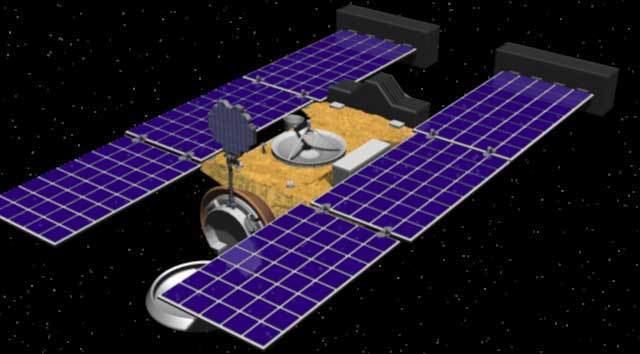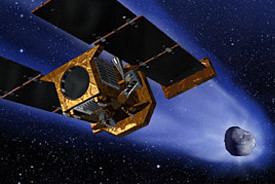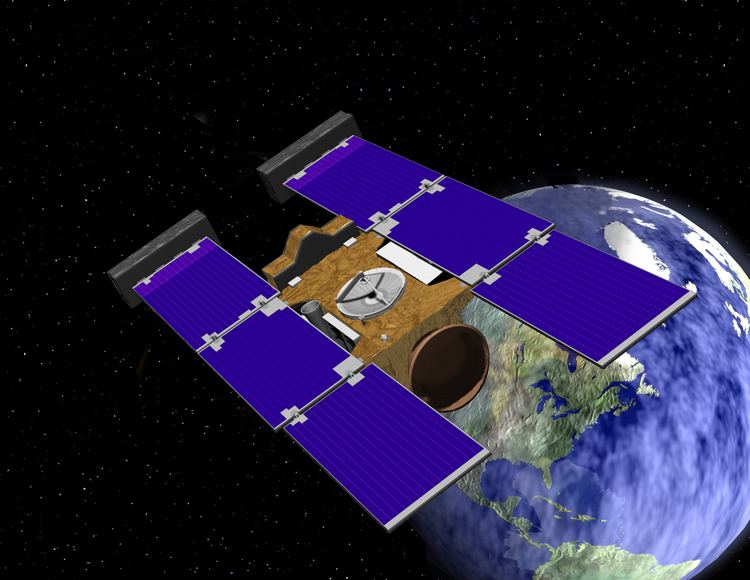SATCAT no. 25618 Launch date 7 February 1999 Launch mass 300 kg | COSPAR ID 1999-003A Website stardust.jpl.nasa.gov Max speed 46,440 km/h Launch mass 300 kg | |
 | ||
Mission duration 6 years, 11 months, 8 days Similar Deep Impact, Deep Space 1, Genesis, NEAR Shoemaker, Ulysses | ||
Stardust was a 300-kilogram robotic space probe launched by NASA on February 7, 1999. Its primary mission was to collect dust samples from the coma of comet Wild 2, as well as samples of cosmic dust, and return these to Earth for analysis. It was the first sample return mission of its kind. En route to comet Wild 2, the craft also flew by and studied the asteroid 5535 Annefrank. The primary mission was successfully completed on January 15, 2006, when the sample return capsule returned to Earth.
Contents
- History
- Spacecraft design
- Attitude control and propulsion
- Communications
- Power
- Computer
- Sample collection
- Stardust microchip
- Launch and trajectory
- Encounter with Annefrank
- Encounter with Wild 2
- New Exploration of Tempel 1 NExT
- Primary objectives
- Encounter with Tempel 1
- End of extended mission
- Sample return
- Sample processing
- Results
- References

A mission extension codenamed NExT culminated in February 2011 with Stardust intercepting comet Tempel 1, a small Solar System body previously visited by Deep Impact in 2005. Stardust ceased operations in March 2011.

On August 14, 2014, scientists announced the identification of possible interstellar dust particles from the Stardust capsule returned to Earth in 2006.

History

Beginning in the 1980s, scientists began seeking a dedicated mission to study a comet. During the early 1990s, several missions to study comet Halley became the first successful missions to return close-up data. However, the US cometary mission, Comet Rendezvous Asteroid Flyby, was canceled for budgetary reasons. In the mid-1990s, further support was given to a cheaper, Discovery-class mission that would study comet Wild 2 in 2004.

Stardust was competitively selected in the fall of 1995 as a NASA Discovery Program mission of low-cost with highly focused science goals. Construction of Stardust began in 1996, and was subject to the maximum contamination restriction, level 5 planetary protection. However, the risk of interplanetary contamination by alien life was judged low, as particle impacts at over 1000 miles per hour, even into aerogel, were believed to be terminal for any known microorganism.

Comet Wild 2 was selected as the primary target of the mission for the rare chance to observe a long-period comet that has ventured close to the Sun. The comet has since become a short period comet after an event in 1974, where the orbit of Wild 2 was affected by the gravitational pull of Jupiter, moving the orbit inward, closer to the Sun. In planning the mission, it was expected that most of the original material from which the comet formed would still be preserved.
The primary science objectives of the mission included:
The spacecraft was designed, built and operated by Lockheed Martin Astronautics as a Discovery-class mission in Denver, Colorado. JPL provided mission management for the NASA division for mission operations. The principal investigator of the mission was Dr. Donald Brownlee from the University of Washington.
Spacecraft design
The spacecraft bus measured 1.7 meters (5.6 ft) in length, and 0.66 meters (2.2 ft) in width, a design adapted from the SpaceProbe deep space bus developed by Lockheed Martin Astronautics. The bus was primarily constructed with graphite fiber panels with an aluminum honeycomb support structure underneath; the entire spacecraft was covered with polycyanate, Kapton sheeting for further protection. To maintain low costs, the spacecraft incorporated many designs and technologies used in past missions or previously developed for future missions by the Small Spacecraft Technologies Initiative (SSTI). The spacecraft featured five scientific instruments to collect data, including the Stardust Sample Collection tray, which was brought back to Earth for analysis.
Attitude control and propulsion
The spacecraft was three-axis stabilized with eight 4.41-N hydrazine monopropellant thrusters, and eight 1-N thrusters to maintain attitude control (orientation); necessary minor propulsion maneuvers were performed by these thrusters as well. The spacecraft was launched with 80-kilograms of propellant. Information for spacecraft positioning was provided by a star camera using FSW to determine attitude (stellar compass), an inertial measurement unit, and two sun sensors.
Communications
For communicating with the Deep Space Network, the spacecraft transmitted data across the x-band using a 0.6-meter (2 ft 0 in) parabolic high-gain antenna, medium-gain antenna (MGA) and low-gain antennas (LGA) depending on mission phase, and a 15-watt transponder design originally intended for the Cassini spacecraft.
Power
The probe was powered by two solar arrays, providing an average of 330 watts of power. The arrays also included Whipple shields to protect the delicate surfaces from the potentially damaging cometary dust while the spacecraft was in the coma of Wild 2. The solar array design was derived primarily from the Small Spacecraft Technology Initiative (SSTI) spacecraft development guidelines. The arrays provided a unique method of switching strings from series to parallel depending on the distance from the Sun. A single nickel hydrogen (NiH2) battery was also included to provide the spacecraft with power when the solar arrays received too little sunlight.
Computer
The computer on the spacecraft operated using a radiation hardened RAD6000 32-bit processor card. For storing data when the spacecraft was unable to communicate with Earth, the processor card was able to store 128-megabytes, 20% of which was occupied by the flight system software. The system software is a form of VxWorks, an embedded operating system developed by Wind River Systems.
Sample collection
Comet and interstellar particles are collected in ultra low density aerogel. The tennis racket-sized collector tray contains ninety blocks of aerogel, providing more than 1,000 square centimeters of surface area to capture cometary and interstellar dust grains.
To collect the particles without damaging them, a silicon-based solid with a porous, sponge-like structure is used in which 99.8 percent of the volume is empty space. Aerogel has 1/1000 the density of glass, another silicon-based solid to which it may be compared. When a particle hits the aerogel, it becomes buried in the material, creating a long track, up to 200 times the length of the grain. The aerogel was packed in an aluminium grid and fitted into a Sample Return Capsule (SRC), which was to be released from the spacecraft as it passed Earth in 2006.
To analyze the aerogel for interstellar dust, one million photographs will be needed to image the entirety of the sampled grains. The images will be distributed to home computer users to aid in the study of the data using a program titled, Stardust@home. In April 2014, NASA reported they had recovered seven particles of interstellar dust from the aerogel.
Stardust microchip
Stardust was launched carrying two sets of identical pairs of square 10.16-centimeter (4.00 in) silicon wafers. Each pair featured engravings of well over one million names of people who participated in the public outreach program by filling out internet forms available in late 1997 and mid-1998. One pair of the microchips was positioned on the spacecraft and the other was attached to the sample return capsule.
Launch and trajectory
Stardust was launched on February 7, 1999, at 21:04:15 UTC by the National Aeronautics and Space Administration from Space Launch Complex 17A at the Cape Canaveral Air Force Station in Florida, aboard a Delta II 7426 launch vehicle. The complete burn sequence lasted for 27 minutes bringing the spacecraft into a heliocentric orbit that would bring the spacecraft around the Sun and past Earth for a gravity assist maneuver in 2001, to reach asteroid Annefrank in 2002 and comet Wild 2 in 2004 at a low flyby velocity of 6.1 km/s. In 2004, the spacecraft performed a course correction that would allow it to pass by Earth a second time in 2006, to release the Sample Return Capsule for a landing in Utah in the Bonneville Salt Flats.
During the second encounter with Earth, Stardust was put into a "divert maneuver" immediately after the capsule was released. The maneuver corrected the spacecraft direction to avoid entering the atmosphere. Under twenty kilograms of propellant remained onboard after the maneuver.
On January 29, 2004, the spacecraft was put in hibernation mode with only the solar panels and receiver active, in a three-year heliocentric orbit that would return it to Earth vicinity on January 14, 2009.
A subsequent mission extension was approved on July 3, 2007, to bring the spacecraft back to full operation for a flyby of comet Tempel 1 in 2011. The mission extension was the first to revisit a small Solar System body and used the remaining propellant, signaling the end of the useful life for the spacecraft.
Encounter with Annefrank
On November 2, 2002, at 04:50:20 UTC, Stardust encountered asteroid 5535 Annefrank from a distance of 3,079 km (1,913 mi). The solar phase angle ranged from 130 deg to 47 degrees during the period of observations. This encounter was used primarily as an engineering test of the spacecraft and ground operations in preparation for the encounter with comet Wild 2 in 2003.
Encounter with Wild 2
On January 2, 2004, at 19:21:28 UTC, Stardust encountered Comet Wild 2 on the sunward side with a relative velocity of 6.1 km/s at a distance of 237 km (147 mi). The original encounter distance was planned to be 150 km (93 mi), but this was changed after a safety review board increased the closest approach distance to minimize the potential for catastrophic dust collisions.
The relative velocity between the comet and the spacecraft was such that the comet actually overtook the spacecraft from behind as they traveled around the Sun. During the encounter, the spacecraft was on the Sun-lit side of the nucleus, approaching at a solar phase angle of 70 degrees, reaching a minimum angle of 3 degrees near closest approach and departing at a phase angle of 110 degrees.
During the flyby the spacecraft deployed the Sample Collection plate to collect dust grain samples from the coma, and took detailed pictures of the icy nucleus.
New Exploration of Tempel 1 (NExT)
On March 19, 2006, Stardust scientists announced that they were considering the possibility of redirecting the spacecraft on a secondary mission to image Tempel 1. The comet was previously the target of the Deep Impact mission in 2005, sending an impactor into the surface. The possibility of this extension could be vital for gathering images of the impact crater which Deep Impact was unsuccessful in capturing due to dust from the impact obscuring the surface.
On July 3, 2007 the mission extension was approved and renamed New Exploration of Tempel 1 (NExT). This investigation would provide the first look at the changes to a comet nucleus produced after a close approach to the Sun. NExT also would extend the mapping of Tempel 1, making it the most mapped comet nucleus to date. This mapping would help address the major questions of comet nucleus geology. The flyby mission was expected to consume almost all of the remaining fuel, signaling the end of the operability of the spacecraft.
The mission objectives included the following:
Primary objectives
Secondary objectives
Encounter with Tempel 1
On February 15, 2011, at 04:42:00 UTC, Stardust-NExT encountered Tempel 1 from a distance of 181 km (112 mi). An estimated 72 images were acquired during the encounter. These showed changes in the terrain and revealed portions of the comet never seen by Deep Impact. The impact site from Deep Impact was also observed, though it was barely visible due to material settling back into the crater.
End of extended mission
On March 24, 2011, Stardust conducted a burn to consume its remaining fuel. The spacecraft had little fuel left and scientists hoped the data collected would help in the development of a more accurate system for estimating fuel levels on spacecraft. After the data had been collected, no further antenna aiming was possible and the transmitter was switched off. The spacecraft sent an acknowledgement from approximately 312,000,000 kilometers (194,000,000 mi) away in space.
Sample return
On January 15, 2006, at 05:57:00 UTC, the Sample Return Capsule successfully separated from Stardust and re-entered the Earth's atmosphere at 09:57:00 UTC, at a velocity of 12.9 km/s, the fastest reentry speed into Earth's atmosphere ever achieved by a man-made object. The capsule followed a drastic reentry profile, going from a velocity of Mach 36 to subsonic speed within 110 seconds. Peak deceleration was 34 g, encountered 40 seconds into the reentry at an altitude of 55 km over Spring Creek, Nevada. The PICA heat shield reached a temperature of more than 2,900 °C during this steep reentry. The capsule then parachuted to the ground, finally landing at 10:10:00 UTC at the Utah Test and Training Range (40°21.9′N 113°31.25′W), near the U.S. Army Dugway Proving Ground. The capsule was then transported by military aircraft from Utah to Ellington Air Force Base in Houston, Texas, then transferred by road to the Planetary Materials Curatorial facility at Johnson Space Center in Houston to begin analysis. NASA officials claimed "prudence" dictated that the materials be transferred in secrecy, though no security threats were apparent.
News related to Stardust lands in Utah successfully at Wikinews
Sample processing
The sample container was taken to a clean room with a cleanliness factor 100 times that of a hospital operating room to ensure the star and comet dust was not contaminated. Preliminary estimations suggested at least a million microscopic specks of dust were embedded in the aerogel collector. Ten particles were found to be at least 100 micrometers (0.1 mm) and the largest approximately 1000 micrometers (1 mm). An estimated 45 interstellar dust impacts were also found on the sample collector, which reside on the back side of the cometary dust collector. Dust grains are being observed and analyzed by a volunteer team through the distributed computing project, Stardust@Home.
In December 2006, seven papers were published in the scientific journal Science, discussing initial details of the sample analysis. Among the findings are: a wide range of organic compounds, including two that contain biologically usable nitrogen; indigenous aliphatic hydrocarbons with longer chain lengths than those observed in the diffuse interstellar medium; abundant amorphous silicates in addition to crystalline silicates such as olivine and pyroxene, proving consistency with the mixing of Solar System and interstellar matter, previously deduced spectroscopically from ground observations; hydrous silicates and carbonate minerals were found to be absent, suggesting a lack of aqueous processing of the cometary dust; limited pure carbon (CHON) was also found in the samples returned; methylamine and ethylamine was found in the aerogel but was not associated with specific particles.
In 2010, Dr. Andrew Westphal announced that Stardust@home volunteer Bruce Hudson found a track (labeled "I1043,1,30") among the many images of the aerogel that may contain an interstellar dust grain. The program allows for any volunteer discoveries to be recognized and named by the volunteer. Hudson named his discovery, "Orion".
In April 2011, scientists from the University of Arizona discovered evidence for the presence of liquid water in Comet Wild 2. They have found iron and copper sulfide minerals that must have formed in the presence of water. The discovery shatters the existing paradigm that comets never get warm enough to melt their icy bulk. In the spring of 2014, the recovery of particles of interstellar dust from the Discovery program's Stardust mission was announced.
Results
The comet samples show that the outer regions of the early Solar System were not isolated and were not a refuge where interstellar materials could commonly survive. The data suggest that high-temperature inner Solar System material formed and was subsequently transferred to the Kuiper Belt.
In 2009 it was announced by NASA that scientists had identified one of the fundamental chemical building blocks of life in a comet for the first time: glycine, an amino acid, was detected in the material ejected from Comet Wild-2 in 2004 and grabbed by the Stardust probe. Glycine has been detected in meteorites before and there are also observations in interstellar gas clouds, but the Stardust find is described as a first in cometary material. Isotope analysis indicates that the Late Heavy Bombardment included cometary impacts after the Earth coalesced but before life evolved. Carl Pilcher, who leads NASA's Astrobiology Institute commented that "The discovery of glycine in a comet supports the idea that the fundamental building blocks of life are prevalent in space, and strengthens the argument that life in the Universe may be common rather than rare."
